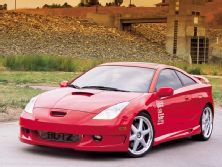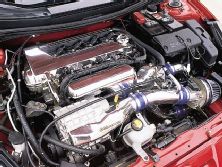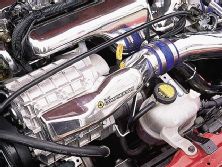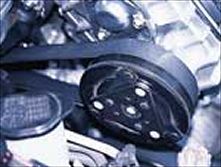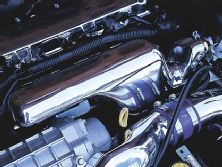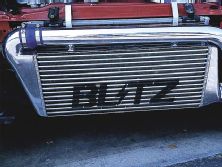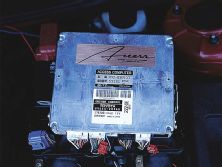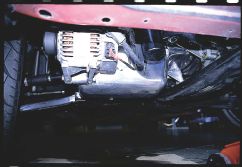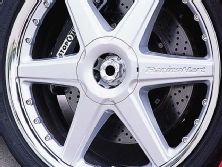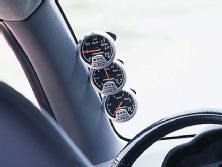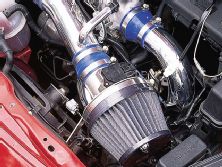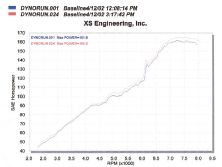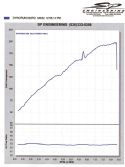The ECU is also responsible for activating the clutch that puts the supercharger to work. Fuel economy is not dramatically affected under cruising conditions since the clutch to the supercharger is left idle and not drawing a load on the pulley system.
Making horsepower is simple right? Slap on an air filter, exhaust and header system and gain 20 hp, right? Well, not really. That may have been true a decade ago when manufacturers still used cast-iron headers and crimp-bent exhaust systems to lower production costs.
Today trying to squeeze extra horses from a late-model import engine can be a bit more challenging. Installing an aftermarket exhaust, header and filter might gain only 10 hp and that is if you're lucky. Many vehicles rolling off the production line already incorporate a tubular header system and mandrel-bent exhaust, laying down a major challenge to the aftermarket. For instance, we squeezed an additional 8.2 hp out of Project Celica by adding a Veilside titanium exhaust and an Injen cold-air intake.
Beyond the simple exhaust and air filter bolt-on, finding performance products for the current-generation Celica ('00 and up) is not an easy proposition. Fortunately for us, our next bolt-on part was already in the on-deck circle before we took delivery of the Celica as a project vehicle.
Blitz Japan had developed a bolt-on supercharger kit for the 2ZZ-GE engine. Having worked closely with Blitz North America, we were able to get our hands on a supercharger kit for the Celica, the first in the States. Upon first inspection, we were immediately impressed with the extra large, front-mount air-to-air intercooler that comes standard in the kit.
Trademark to most Japan intercoolers, the Blitz unit utilizes a tube-and-fin design for heat dissipation of the charge air. Pressure drop is crucial, considering the boost pressure is limited to 0.48 bar (7.0 psi) by the supercharger pulley. Testing by Blitz engineers has resulted in only a .05 bar (.735 psi) loss of pressure at 1.0 bar (14.7 psi) of boost.
On our supercharged Celica, we noticed peak boost pressure at the throttle body was 0.43 bar (6.3 psi) compared to the 0.48 bar at the supercharger outlet, a nominal loss of 0.05 bar. The intercooler measures over two feet (24.02 inches) across, dominating the front-end fascia of the Toyota. The I/C system's lightweight aluminum makes it a perfect candidate for polishing, which we elected to perform on our system.
Also standard in the supercharger kit is a new cast-aluminum intake manifold and oil pan. Both components are key pieces in the supercharger's installation.
However, most impressive was the reprogrammed factory ECU. Unlike many force-induction kits that typically utilize an aftermarket pump and boost dependent regulator for fuel enrichment, the Blitz supercharger kit incorporates a reprogrammed factory ECU for complete fuel and ignition tuning, which is critical considering the Toyota's single-line fule system.
The Blitz ECU creates more precise tuning and eliminates the chances of overloading the cylinder with fuel, commonly a problem with pump and regulator systems. Also, the chances of detonating from being too advanced on ignition timing or pre-ignition from too much retard is nonexistent.
Upon installation of the supercharger, we noticed the entire installation manual was in Japanese. Don't worry. Blitz is working on a U.S. manual. Fortunately, there were plenty of pictures to guide us through the installation. The kit required relocation of the alternator underneath the air conditioning pump. It actually mounted directly to the new oil pan.
The kit also came with an extension harness for the alternator, so we didn't need to cut and extend the electrical wires. After installing the oil pan and relocating the alternator everything was pretty straightforward. The supercharger mounted with all the corresponding brackets and the intricate pulley system was all tied together with the supplied drive belt. The intercooler mounted perfectly and all the aluminum I/C piping lined up properly.
Besides removing the factory ECU to install the reprogrammed unit, the only other wiring that needed to be installed was the relay to activate the clutch on the supercharger. The only tricky part was contouring the factory dipstick tube around the supercharger outlet.
Driving the Celica with the supercharger took a little getting used to, especially on turns. Activation of the supercharger on a turn could easily have left large patches of rubber on the pavement. And remember, the Celica is rolling on some pretty wide 225/35R-19 Yokohama Parada Spec-2 tires and still easily smokes the hides.
Since the supercharger is clutch-activated, boost pressure was instantaneous. The effect was similar to a nitrous kit being activated. Unlike a turbocharger where boost pressure is gradual, the Blitz supercharger reached peak boost almost immediately. Throttle response was extremely crisp, no stumbles or misfires, just pure acceleration.
The 2ZZ-GE engine willingly screamed to redline once the accelerator was to the floor but can still be extremely civil in stop-and-go traffic. Overall, fuel economy was not greatly affected, except during the first two tanks of gas when we had the accelerator on the floorboard everywhere we went. Fuel economy was still about 22 to 25 miles per gallon.
On the dyno the Toyota pumped out 198.9 hp on 91-octane gas; peak power was increased by 33.6 hp. With the air/fuel meter hooked up, we noticed the engine was running a little lean at the top-end. From 7000 rpm to redline, the air/fuel ratio crept into the 13.0 range, but we didn't hear any detonation or see any slivers of aluminum on the plugs.
Since we are still running the Japan ECU which was tuned for 100 octane we weren't really surprised to see the air/fuel get so lean. Blitz will reprogram the ECU for 91-octane fuel in the U.S. version of the kit, so we hope to see an even larger horsepower gain on the dyno.
The Celica is a real looker, constantly turning heads each time we take it for a cruise but don't let the looks fool you. The front-mount intercooler hints that this Celica is ready to run.
the SOURCE
Blitz
Dept. THP, 4879 E. La Palma Ave., Ste. 206
Anaheim, CA 92807
(714) 777-9766
DAZZ Motorsports
(Racing Hart Distributor)
Dept. THP, 5121 Commerce Dr.
Baldwin Park, CA 91706
(626) 962-0033
Fiber Images
(661) 274-9500
H&R Springs
(888) 827-8881
Injen Technology
Dept. THP, 244 Pioneer Pl.
Pomona, CA 91768
(909) 839-0706
Kamanari USA
Dept. THP, 12601 Western Ave.
Garden Grove, CA 92841
(800) Buy-Kit
Veilside
(310) 835-5684
Yokohama Tires
(800) 366-Tire

